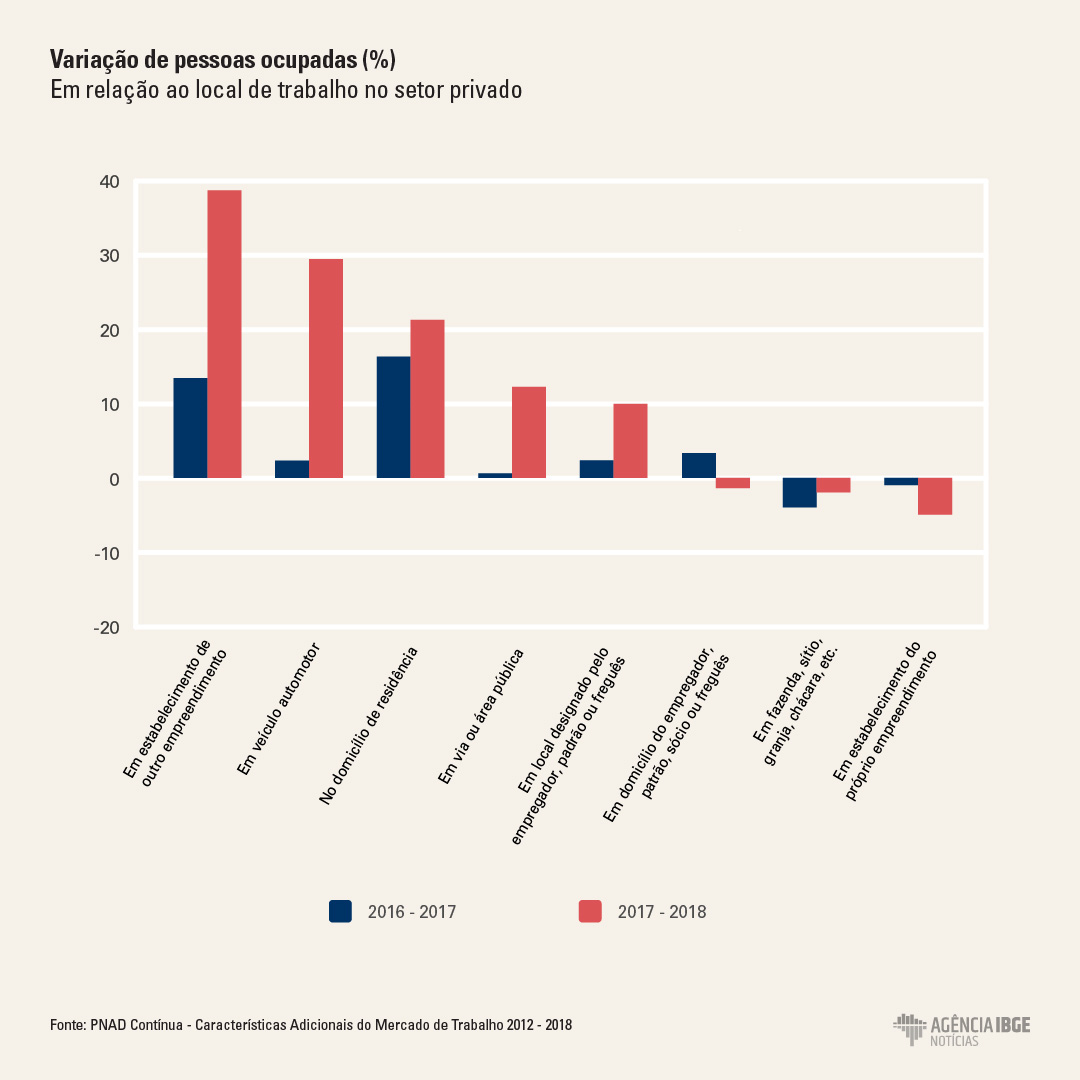Continuous PNAD
Number of workers behind the wheel grows 29.2%, the series' highest rise
December 18, 2019 10h00 AM | Last Updated: December 18, 2019 04h06 PM

The population working in vehicles, such as application drivers, taxi drivers, and bus drivers and ticket collectors, increased by 29.2% in 2018 to 3.6 million, with 810,000 more people than in 2017. It is the greatest high in percentage and absolute terms since 2012, when the time series of the Continuous National Household Sample Survey (Continuous PNAD), released today (18) by IBGE, began.
Those who work in a place designated by the employer, boss or customer, including delivery persons in general, also had the greatest contingent and the highest increase since 2012. There are 10.1 million in 2018 in this condition, a rise of 9.9 % compared to 2017, equivalent to 905 thousand more people.
"The recent highs may be related to the growth of passenger transportation and mobile application deliveries, reflecting changes in the current economy," said IBGE researcher Ms. Adriana Beringuy.
The survey also showed a 12.1% increase in the number of Brazilians who worked on the streets compared to 2017, totaling 2.3 million people. These people include, for example, street vendors.
The largest percentage change related to the workplace, however, was for people working in facilities at other enterprises, up 38.3%. "This may indicate a growth in outsourcing in companies," Ms. Beringuy explained.

Between 2012 and 2014, the number of employed persons working in a vehicle or in a public area remained fairly stable, ranging from 2.6 million in the first group to 1.8 million in the second.
From 2015 on, there was a slight increase among those who worked in vehicles, but without major variation until 2017. The North (5.3%) and Southeast (5.2%) Regions had the highest percentages of employed persons in vehicles in 2018.
On the other hand, those whose workplaces are public roads, had a skyrocketed from 2015 to 2016, from 1.8 million to 2 million (12.4%), and rose again from 2017 to 2018, going from 2.1 million to 2.3 million (12.1%). In the Southeast, there was the largest expansion (23.9%), with a contingent of 686 thousand people. But the Northeast Region remained with the largest number of people employed on the road or public area: with 957 thousand people.
Regarding people who worked in a place designated by the boss or customer, the group started the series with a high of 7.2% in 2013, but in the following years, showed little oscillation, recording a slight fall in 2016. In 2017, it grew a little once again (2.3%) and, in 2018, jumped to an almost 10% growth.
Home office up 21.1%
Another strong increase was that of people working at home. Between 2016 and 2017, the number of workers whose place of work was their place of residence increased by 16.2%, and, between 2017 and 2018, it increased by 21.1%. Between 2012 and 2014, there was a drop in this group. In 2015, a high of 7.3%; In 2016, it fell again (-2.2%).
On the other hand, the number of people working in the enterprise's own facilities has gradually decreased since 2015. However, the 4% drop between 2017 and 2018 was a little steeper.
Another retraction was at farms and ranches. “There is a gradual downward trend observed since the series began in 2012. This decrease is linked to the process of rural exodus and the mechanization of processes,” said Ms. Beringuy.
Self-employment regains growth trend
The percentage of self-employed has increased again. “Between 2012 and 2016, there was an increase in the number of employers or self-employed persons who were in enterprises registered with the National Register of Legal Entities (CNPJ), reaching 29% in 2016. In 2017, this share fell to 28.1%, growing again in 2018, with a return to the same value as that of 2016,” said Ms. Adriana Beringuy.
The proportion of CNPJ registration is higher among women (29.8%) than among men (28.6%). "There is a predominance of women registered with the CNPJ both as self-employed and as an employer," said Ms. Beringuy. Among female employers, 84.3% had the CNPJ, while among men this proportion was 77.2%.
And the sector that concentrated the largest distribution of employers or self-employed persons in the main job in the period was Trade and repair of motor vehicles and motorcycles (42.7%), followed by Services (34.7%).
In regional terms, the North (13.4%) and the Northeast (16.3%) had the lowest CNPJ coverage, whereas the South, the largest (39.8%). Compared to 2017, only the Central-West showed a decrease in this type of registration, from 31.7% to 30.5%. Compared to 2012, the percentage growth of CNPJ registered workers in the Northeast reached 38%.




















